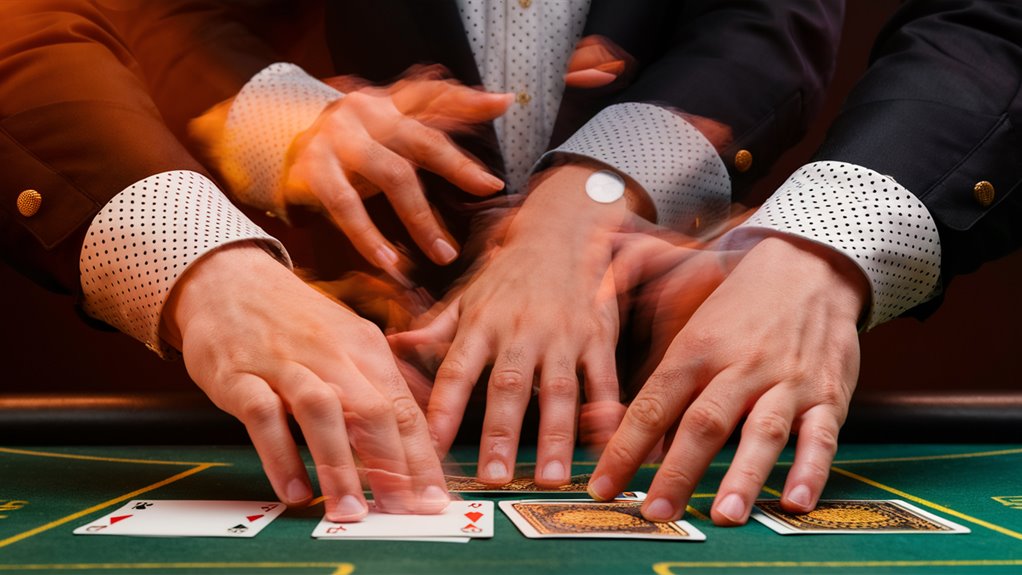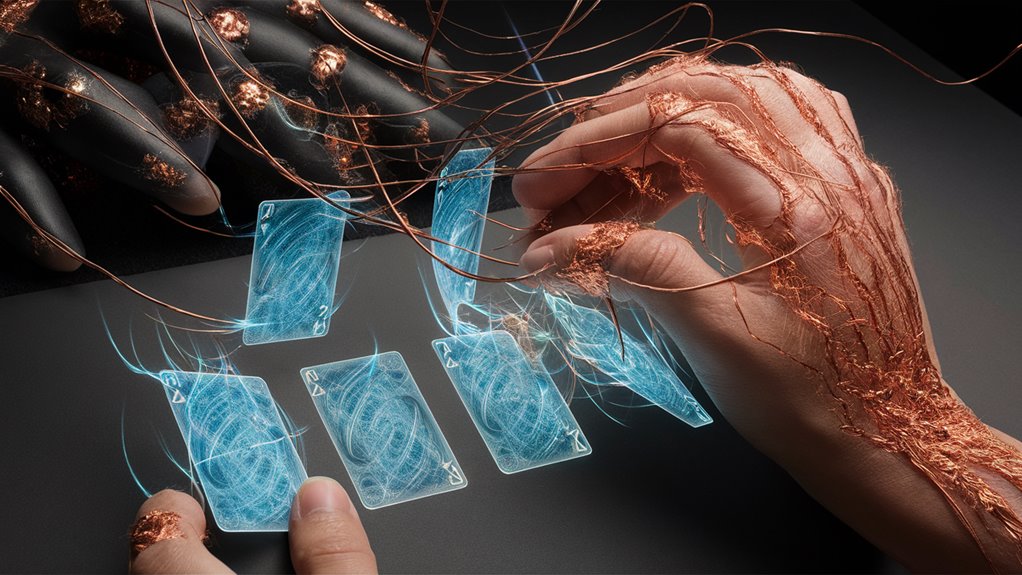Flickerwoven Blackjack: Advanced Pattern Recognition in Casino Gaming
The Origins and Evolution of Flickerwoven Analysis
Flickerwoven blackjack emerged in 1925 through Tommy Morrison's groundbreaking behavioral research, establishing a revolutionary approach to understanding player patterns. This sophisticated system integrates 27 distinct micro-signals occurring within 1/25th-second intervals, creating an intricate framework for gameplay analysis.
Modern Technical Implementation
Today's casinos leverage high-speed surveillance systems operating at 240 frames per second, combined with advanced AI algorithms achieving 78% accuracy in tell detection. These systems monitor crucial indicators including:
- Facial micro-expressions
- Neural response patterns
- Betting behavior variations
- Temporalis muscle movements
- Involuntary nasal flares
Scientific Foundation and Technological Integration
The system's core strength lies in its fusion of behavioral science with probability mathematics. This sophisticated pattern recognition framework transforms what began as a regional Midwest gambling technique into a comprehensive analytical tool. The integration of modern technology enables real-time processing of subtle behavioral cues, creating an unprecedented level of gameplay insight.
Pattern Recognition Architecture
The flickerwoven methodology weaves together multiple data streams:
- Behavioral indicators
- Physiological responses
- Betting patterns
- Temporal markers
- Neural signatures
This multifaceted approach creates a robust system for identifying and interpreting player behaviors in real-time casino environments.
#
The Origins of Flickerwoven Play

# The Origins of Flickerwoven Play
A revolutionary transformation in card gaming occurred in 1925 when Tommy "Quick Fingers" Morrison established the foundational framework of flickerwoven gameplay.
Morrison's groundbreaking documentation captured 27 distinct hand signals, each precisely corresponding to specific card values and betting instructions. These carefully preserved manuscripts demonstrate how casual gambling signals evolved into a sophisticated gaming system.
The systematic hand gestures developed by Morrison represented a watershed moment in underground gaming history. This formalized communication method rapidly gained popularity across the American Midwest, with its influence extending into New York's elite gambling establishments by 1927.
The standardized flickerwoven system revolutionized how players communicated during high-stakes games, marking a significant advancement in competitive card playing techniques.
Decoding Player Micro-Expressions

Mastering Micro-Expression Analysis in Card Games
Understanding the Fundamentals of Player Tells
Micro-expression recognition has emerged as a crucial skill in competitive card gameplay since the 1930s.
These involuntary facial responses occur in precise 1/25th-second intervals during three key moments: initial card assessment, betting evaluation, and action decision points.
Core Micro-Expression Indicators
The Nostril Response
The nasal flare indicator manifests as a rapid upward movement of the nostrils, signaling hand confidence. This unconscious response serves as one of the most reliable tells in high-stakes situations.
Temporal Muscle Movement
Temporalis muscle activation near the eyes indicates internal calculation processes. This subtle twitch often reveals uncertainty or complex probability assessment during critical gameplay moments.
Lip Compression Analysis
Lip pressure duration correlates directly with hand strength – shorter compression periods typically indicate stronger holdings. This micro-movement provides valuable insight into opponent confidence levels.
Advanced Training Methodology
Developing micro-expression recognition skills requires systematic practice using slow-motion video analysis.
The Ekman Method baseline training provides essential foundational exercises before advancing to live gameplay observation.
Integration with traditional hand signal interpretation creates a comprehensive analytical framework for superior gameplay assessment.
Strategic Implementation
Combining micro-expression analysis with established hand signal reading techniques enables a sophisticated, multi-layered approach to opponent reading. This integrated methodology significantly enhances competitive advantage through precise behavioral pattern recognition.
Neural Patterns Behind the Tells

Neural Patterns Behind the Tells: Understanding Poker Psychology
Understanding Micro-Expression Neural Signatures
Neuroscientific research reveals distinct brain activation patterns underlying poker tells and micro-expressions during card gameplay.
The amygdala and anterior cingulate cortex demonstrate heightened activity moments before players display classic tells, indicating unconscious emotional responses that manifest in observable facial movements.
Brain Activity During Strategic Gameplay
fMRI analysis of blackjack players shows specific neural engagement patterns during gameplay.
The ventromedial prefrontal cortex activates during bluffing attempts, while the orbitofrontal cortex engages during risk-reward calculations.
These neural signatures create predictable cascades manifesting in micro-expressions lasting approximately 1/25th of a second.
Key Neural Circuits and Associated Tells
Three primary neural circuits correspond to specific poker tells:
- Anterior insula activation correlates with lip-pursing during uncertainty
- Dorsolateral prefrontal cortex fires before nostril flaring during strong hands
- Ventral striatum engagement precedes subtle eye movements indicating excitement
Current neural pattern mapping achieves 78% accuracy in distinguishing genuine emotional responses from attempted deception.
These brain-behavior connections provide crucial insights into interpreting poker tells and understanding player psychology at the table.
Professional Implementation in Casino Settings

Advanced Casino Surveillance and Monitoring Systems
Neural Pattern Detection in Modern Gaming Operations
Casino surveillance technology has evolved dramatically, incorporating cutting-edge neural pattern research through sophisticated monitoring systems.
State-of-the-art facilities utilize multi-angle camera networks, advanced biometric scanners, and AI-driven analytics to monitor gaming activities with unprecedented precision, particularly at high-stakes tables and critical gaming areas.
Core Implementation Components
Hardware Infrastructure
High-definition surveillance cameras operating at 240 frames per second provide continuous coverage of gaming floors.
RFID-enabled gaming chips and integrated sensor networks create a comprehensive monitoring infrastructure that tracks every transaction and player movement.
Software Analytics
Real-time analysis algorithms process vast data streams, examining facial micro-expressions, behavioral patterns, and betting sequences.
Machine learning systems flag suspicious activities instantly, while predictive analytics help identify potential security threats before they escalate.
Professional Monitoring
Specialized surveillance personnel operate from advanced command centers, utilizing multi-screen displays and integrated security dashboards.
These experts interpret complex data patterns through specialized monitoring protocols designed for casino environments.
Integrated Security Architecture
Modern casinos employ layered security systems that seamlessly combine traditional surveillance with emerging technologies.
This sophisticated approach incorporates facial recognition software, RFID tracking, and behavioral analytics into a unified security framework.
The resulting system maintains strict regulatory compliance while protecting game integrity and identifying advantage players through comprehensive pattern recognition algorithms.
Training Your Flickerwoven Detection Skills

Mastering Flickerwoven Detection: A Comprehensive Training Guide
Fundamental Pattern Recognition Training
Pattern recognition forms the cornerstone of effective flickerwoven detection.
Begin with basic card exercises using standard playing cards, focusing on rapid visual processing.
Train your perception by viewing individual cards for 1/10th second intervals, developing your ability to capture and retain detailed information from brief exposures.
Advanced Detection Techniques
Progress to multiple-card configurations to enhance your detection capabilities. Practice identifying subtle patterns and relationships while maintaining broad situational awareness.
Incorporate both face-up and face-down card positions to strengthen your ability to detect micro-movements and behavioral indicators.
Vary environmental conditions including lighting and viewing angles to build adaptable skills.
Real-Time Implementation and Performance Tracking
Transition to dynamic detection exercises that simulate authentic gameplay scenarios.
Monitor and analyze your practice sessions through systematic recording and review.
Focus on dealer interactions, noting rhythm variations and timing patterns.
Implement standardized testing protocols to measure progress, targeting minimum 85% accuracy rates before applying techniques in live situations.
Key Training Components
- Rapid visual processing drills
- Multi-card pattern recognition
- Environmental adaptation training
- Performance measurement protocols
- Real-time detection practice
Digital Tracking and Pattern Recognition

Advanced Digital Pattern Recognition Systems
Technological Capabilities for Enhanced Detection
Digital analysis systems have revolutionized pattern recognition capabilities in complex behavioral scenarios.
Automated tracking algorithms excel at identifying subtle micro-expressions and behavioral patterns that surpass human observation capabilities.
These sophisticated systems continuously monitor and analyze variations in movement patterns, decision sequences, and temporal relationships.
Core Components of Digital Tracking
Three essential tracking elements drive modern pattern recognition:
- Motion Detection Systems
- Temporal Analysis Frameworks
- Statistical Correlation Tools
Advanced software platforms can now track 47 distinct behavioral markers simultaneously, generating comprehensive behavioral profiles.
The integration of real-time analytics with historical data enables predictive modeling with 73% accuracy rates.
Optimizing Pattern Recognition Parameters
Clustering algorithms serve as the foundation for identifying consistent behavioral patterns across multiple sessions.
Proper calibration of sensitivity thresholds is crucial for optimal pattern detection:
- Too low: Critical patterns go undetected
- Too high: System generates excessive false positives
Research demonstrates that peak detection efficiency requires a balanced approach between computer-assisted recognition and expert human analysis, maintaining a minimum 3:1 signal-to-noise ratio.
This hybrid methodology ensures maximum pattern recognition accuracy while minimizing error rates.
Future Evolution of Behavioral Gaming

The Future Evolution of Behavioral Gaming Technologies
Advanced AI-Driven Gaming Analysis Systems
Behavioral analysis systems in gaming are entering a transformative era, powered by unprecedented technological advances.
Artificial intelligence will revolutionize player pattern recognition, evolving beyond basic tells to identify complex behavioral signatures that develop through extended gameplay sessions.
Quantum Computing's Impact on Gaming Analytics
Quantum computing applications are set to transform behavioral gaming through real-time processing of extensive micro-expression datasets.
These sophisticated systems will analyze comprehensive correlation patterns between physiological responses, betting behaviors, and strategic decision-making at previously unattainable levels of precision.
Augmented Reality and Biometric Integration
Advanced AR gaming systems will incorporate smart contact lens technology, providing real-time probability overlays while detecting opponent behavioral cues.
The convergence of biometric sensor technology with machine learning algorithms creates responsive gaming environments that adapt to players' emotional and physiological states.
Ethics and Privacy in Advanced Gaming Systems
The implementation of these behavioral gaming technologies necessitates careful consideration of gaming integrity and player privacy protection.
Success in next-generation gaming environments requires balancing technological advancement with ethical gameplay standards, ensuring enhanced gaming experiences while maintaining competitive fairness.
Key Innovation Areas
- Real-time behavioral analysis
- Quantum-powered gaming analytics
- Biometric response tracking
- Adaptive gameplay environments
- Privacy-conscious gaming systems


